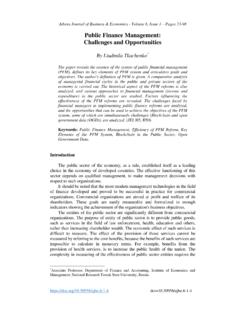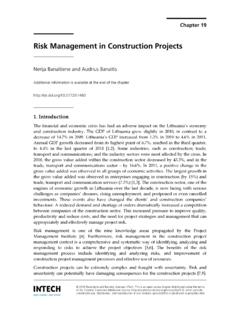Transcription of Government Privatization - Illinois General Assembly
1 Government Privatization History, Examples, and Issues Commission on Government Forecasting and Accountability 703 Stratton Office Building Springfield, Illinois 62706 October 2006 Commission on Government Forecasting and Accountability COMMISSION CO-CHAIRMEN Senator Jeffrey M. Schoenberg Representative Terry R. Parke SENATE HOUSE Don Harmon Mark H. Beaubien, Jr. Christine Radogno Frank Mautino Steven Rauschenberger Robert Molaro David Syverson Richard Myers Donne Trotter Elaine Nekritz EXECUTIVE DIRECTOR Dan R. Long DEPUTY DIRECTOR Trevor J. Clatfelter REVENUE MANAGER Jim Muschinske AUTHOR OF REPORT Benjamin L. Varner EXECUTIVE SECRETARY Donna K. Belknap TABLE OF CONTENTS Government Privatization : History Examples, and Issues PAGE Executive Summary i I. Privatization 1 II. Forms of Privatization 1 III. Privatization around the World 3 IV.
2 Reasons for Privatization 4 V. Valuation of Assets 7 VI. Privatization Examples 9 VII. Issues Associated with Privatization 19 VIII. Conclusion 21 TABLES: 1 Risk Distribution in Various Delivery Systems 5 2 Net Present Value Example 8 3 Internal Rate of Return Example 8 4 Illinois Tollway Revenues and Expenses 11 5 Prisoners Held in Private Facilities 14 APPENDIX: A Weighted Average Cost of Capital (WACC) 22 B Map of the Illinois Tollway System 24 C IDOC Facility Information, FY 2003 25 EXECUTIVE SUMMARY With the growing trend of Privatization and public private partnerships in state and local governments, the Commission has put together this report to inform interested parties on forms of Privatization , the history of Privatization , reasons for Privatization , methods of valuing public assets, examples of Privatization that could be relevant to Illinois , and issues associated with Privatization .
3 Some highlights of the report are: Privatization is the process of transferring property from public ownership to private ownership and/or transferring the management of a service or activity from the Government to the private sector . Types of Privatization include complete Privatization , Privatization of operations, Privatization through contracts, franchising, and open competition. Privatization of public assets has historically occurred more frequently outside the United States. This is most readily seen in nationally run industries in former socialist countries that are moving towards more free market economies. Privatization of public services has occurred at all levels of Government within the United States. Some examples of services that have been privatized include airport operation, data processing, vehicle maintenance, corrections, water and wastewater utilities, and waste collection and disposal.
4 Reasons for Privatization include cost reduction, risk transfer, a source of revenue, the desire for a higher level of service, a need for greater expertise, and flexibility. Commonly used methods of valuing public assets include net present value, internal rate of return, and multiples. Common areas of Privatization that are examined in this report include: 1. Toll Roads, Bridges, and Tunnels (Page 9), 2. Utilities (Page 12), 3. Corrections (Page 14), 4. Lotteries (Page 15), 5. Loan Portfolios (Page 16), 6. Airports (Page 16), 7. and Other Assets and Services (Page 17). Issues associated with Privatization include the affects to public employees, transparency after Privatization , ownership of public assets, competition within the system, and the importance of the contract or agreement. i I. Privatization As defined by Wikipedia, Privatization (also known as denationalization or disinvestment) is the process of transferring property from public ownership to private ownership and/or transferring the management of a service or activity from the Government to the private sector .
5 Privatization can be partial or complete. It may also carry conditions as to the change in ownership. In recent years, public private partnerships have become a regular tool for national, state, and local governments to more conveniently fulfill their duties. By involving groups from the private sector , governments have tried to improve the way they perform their duties especially concerning infrastructure improvement projects. Governments have transferred over design, construction, operation, and maintenance responsibilities to the private sector based on the belief that the private sector can fill these needs more efficiently than the Government could. Governments are also leasing or selling established Government assets, such as toll roads or loan portfolios, in exchange for upfront cash payments.
6 These moneys are used towards new projects or put towards other Government needs. II. Forms of Privatization Five forms of Privatization are identified by Richard C. Brooks in his paper Privatization of Government Services: An Overview and Review of the literature . These five forms of Privatization are: Complete Privatization , Privatization of Operations Use of Contracts, Franchising, and Open Competition. Complete Privatization Complete Privatization is the outright sale of Government assets to the private sector . This type of Privatization not only confers assets but also the related responsibilities of ownership to the private sector . Government run industries and assets have generally been completely privatized through one of three main ways. The first way is share issue Privatization . The Government sells shares of the Government run company which can then be traded on various stock markets.
7 Share issue Privatization has been the most prevalent method used, though a developed secondary market is necessary. The second method is through asset sale Privatization . In this method, the whole firm or asset is sold to an investor. This is usually done by auction. The final method is voucher Privatization in which shares of ownership are distributed to all citizens for -1-free or for a very low price. Complete privatizations have been seen mostly in the transition economies of Central and Eastern Europe in recent years. Complete Privatization has been somewhat rare in the United States due to the market driven economy and federal regulations associated with the sale of public assets that were built using federal grants. An example of this kind of transaction in the can be seen in the sale of the Fairbanks Municipal Utilities System for $100 million in 1996.
8 The company was sold by the City of Fairbanks under provisions that kept utility rates within certain ranges and provided for stable employment. Privatization of Operations The Privatization of operations is the turning over of managerial and operational responsibilities of publicly owned facilities to private sector firms. This kind of Privatization is often seen with the running of sports and concert venues. Under this arrangement, the private sector firm generates revenue through the collection of fees from individual customers of the Government asset. For example, the sports stadiums in New York City are managed by the baseball teams that use the facilities during the baseball season but are run by the New York City Department of Parks during the off season. This kind of arrangement can also be seen in transactions concerning the operation and maintenance of toll roads and toll bridges.
9 Contracting Out Contracting out is the production of designated services by a private firm under a contract. Under this scenario, the private sector firm is paid directly by the Government for their services. The Government finances these services through the taxes or the collection of user fees. This type of arrangement is commonly used for the collection and disposal of solid waste. Other types of services that have been privatized through this type of agreement include security services, data processing services, and consulting services for numerous professions. Franchising Franchising is the awarding of exclusive rights to perform services within a specific geographic area to a private firm by a governmental unit. The private firm generates revenue by collecting user fees. Cable television is the most common example of this kind of Privatization .
10 Utilities such as electricity, gas, and water service could also fall under this category. -2-Open Competition Open competition is the last form of Privatization under this classification. Open competition is similar to pure competition as many private firms are allowed to compete for customers within a governmental jurisdiction. This type of Privatization can potentially be seen in telephone and internet service providers. This type of Privatization is not appropriate for some services as it most likely would not be efficient to have multiple suppliers of electricity, gas, or water service. III. Privatization around the World Privatization outside the Privatization has occurred numerous times around the world especially in former socialist countries. Nationalized industries were often privatized as socialist leaning countries moved towards a more market oriented economy.











